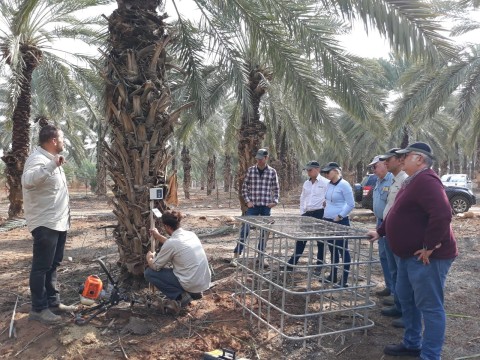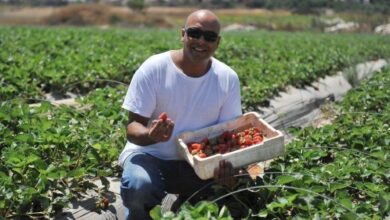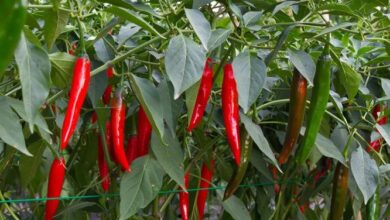NaanDanJain cooperates with Ag-Tech start-ups to benefit farmers and save water
The goal of providing an holistic solution to the three primary variables influencing the growing process : Soil, Water and Crop.
Interview with NaanDanJain's Senior Agronomist, Yonatan Gelman


naandanjain is one of the world’s leading companies in development and manufacture of irrigation solutions. in this era when knowledge equals power, naandanjain understands its clients’ needs, and accordingly cooperates with ag-tech companies to offer farmers with “decision-makining supporting innovative systems” produced by those companies. naandanjain, as a global corporation, constitutes a line of communication between those companies and the farmers.
in early february naandanjain held a conference on ag-tech, attended by 12 representatives of its subsidiaries worldwide, to train them as ag-tech resource people in their respective countries. in addition to theoretical background, they received practical training in the root sense system for precision irrigation and the gavish fertigation and climate control systems, visited farmers, installed systems and learned how to fix malfunctions. the conference was held at kefar ruth and naan, in cooperation with viridix, producer of root sense.

naandanjain is developing a line of ag-tech products, with the goal of providing an holistic solution to the three primary variables influencing the growing process and its success : soil, water and crop. the more accurate the information the farmer receives about these three parameters, the more accurate his decision making process will be, as well as the results. naandanjain sees to it that the farmer receives data easily, simply and reliably.
soil—for over four years various precision irrigation technologies were tested by naandanjain and experiments were run at various sites, including the avocado orchard at kibbutz naan.
yonatan: “based on the feedback we received from the field, we singled out root sense as the product of choice that provides the best solution to reflect the crop’s water consumption. it also has a winning combination of precise, clear data with simple operation, which is a viridix specialty.

root sense is a decision making system for the farmer and by the farmer(or with the help of his agronomist). it measures the soil’s water potential, which naandanjain’s staff considers the most correct index for receiving data about the amount of energy the plant needs to invest in order to draw the water out of the soil.
root sense system offers a solution for the drawbacks of other systems existing on the market
many existing systems use technology based on measuring the electrical conductivity of the soil (ec) that translates into volumetric water content; the system is problematic due to the variability of soil content in different parts of the field.
yonatan: “the values received can change from one location to the next, and the interpretation of those values to field capacity or wilting point is depending on soil types – sandy soil holds water differently from clay-like soil, therefore using this technology requires specific calibration of sensor units for each location”.
another old system familiar to farmers is measuring with a tensiometer, which has several innate problems requiring calibration and onsite adjustments.
by contrast with those systems, the root sense system adopted by naandanjain is based on a root-like sensor in the shape of a cable with a ceramic tip, which can be treated like another root (assuming that if the “root sense root” absorbs easily, the plant’s root apparently absorbs easily as well). data gathered by the sensor arrive at the data logger with its electronic components, and a battery is recharged by a small solar panel, including a sim card that transmits real-time data to the cloud.
the farmer receives on-line updates about the soil’s water status.

the root sense system provides information about water tension in the soil, and copes with the problems of traditional tensiometers:
– no water is used, measurement is done by chemical material within the sensor.
– the measurer is not a pole but rather a cable, or actually two cables that constitute two sensors, enabling installation in various ways – next to the roots, including in detached substrate. cannabis growers use that method because it is the only sensor that can be inserted even in smaller volumes of 10-20 liters, and provides highly precise tension readings.
– flexibility – for example in detached substrates, it doesn’t have to be placed inside the same sack, but can be set up in two separate sacks; a single system can be used to measure two different planters.
– installation of the sensor at the tip of the cable can also be horizontal –there is uninterrupted sensor contact with the soil, preventing occurrence of an air pocket around the sensor.
– it doesn’t require periodic maintenance – doesn’t need water filling, one hour of sunlight on the solar panel is enough to recharge the battery. in-field installation is very easy.

water – naandanjain partners with leading irrigation control companies to produce monitoring and control for irrigation systems, all of which share the ability to receive data from the cloud, and accordingly to provide recommendations for operation of the irrigation system.
an example of this type of system is jain logic – a system for monitoring irrigation that provides the farmer all possible data about the irrigation system. according to yonatan, for some farmers this is an ideal system, since it gives them information for whole irrigation line, from the water level in the tank, through monitoring the supply pump, pressure, laterals flow meter, to soil moisture level in the roots area.
.jpg)
crop– yonatan: “our challenge is to provide each farmer with information about the amount of water the plant has lost, so the farmer will know what amount of water must be returned to the plant.” he argues that there are different approaches to irrigation, some based on information about soil condition or plant condition. “we support cross-checking information and giving the farmer both angles of information.” in parallel naandanjain is partnering with another company to receive high
resolution satellite photos of plant conditions, which are analyzed and translated into more specific data that will give a pin-point picture of the crop for the farmer’s benefit.

system pricing – yonatan states that “our goal is that every farmer will be able to distribute enough systems in his field to provide a real reflection of the natural variability between fields, so the farmer will easily be able to return the cost of investment while working, as a direct expression of reduced manufacturing costs – he will learn to irrigate correctly according to plant requirements, and according to the soil’s capacity to retain water, which will be expressed both through healthier crops as well as higher yields”.
naandanjain, as a link in the chain, connects agtech companies with farmers, and makes sure that they receive after-sales support. yonatan: “this is a communications format in which the farmer pays for a service package that includes:
– cloud data storage, remote support, software support and also an automatic warning system that comes with default settings and can be edited and changed by the farmer”.
naandanjain maintains close ties with its clients, the farmers, is attentive to their needs, endeavoring to bring them innovative technologies to help them cope with intensely competitive agriculture, due to the challenges of our times.




